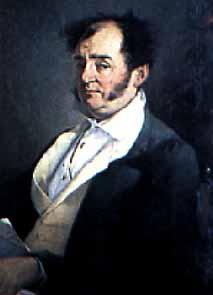

A famous 19th century naturalist, Esprit Requien is Avignon's most illustrious scientist. Coming from an old, established bourgeois family, he devoted himself to botany. He catalogued the first botanical inventory of Corsica and carried out the first vertical survey of the vegetation of the Mont Ventoux; he worked very actively with the Botanical Garden and built up a herbarium that remains today a reference (it is considered the fifth largest in France).
A forerunner in phytosociology with a very eclectic mind, he was interested in just about all the Sciences, notably paleontology and malacology, branches for which he assembled rich collections. Esprit Requien was in contact with the greatest scientists of his time such as Egerton, d'Orbigny, de Candolle, Bentham... who, in homage, named many new species after him (75): Requienia ammonia, Narcissus requieni....
He himself was the author of many descriptions (109), notably in botany and malacology: Mentha insularis, Narcissus juncifolius, Venus picturata ....
Esprit Requien was the son of a tanner who had his workshop on the Rue de l'Ombre (Rue Cassan); Esprit was born there in 1788 and spent most of his life there. The critic Armand de Pontmartin, a friend of the naturalist, recounts in his memoirs Seconde Jeunesse: "His hospitality equalled his knowledge. I have known few people more expansive, more cordial, more friendly, more absolute... As his repasts were excellent, his Sunday dinners...were a universal success. I saw at that hospitable table the Duke de Luynes, Horace Vernet, Paul Delaroche, Marmier, Méry, Ampère, Fauriel, M. de Mirbel, ... Champmartin, Liszt, Castil-Blaze...and naturally Mérimée. "
The correspondence between Prosper Mérimée and Esprit Requien has remained famous; their letters were published in 1898 in the Revue de Paris.
Through them we learn, for example, that the two Historic Monuments inspectors raged against the project from an engineer, Talabot, that had seduced the town council at the time: laying railway tracks on the ramparts! The station would have been built at the Porte de l'Oulle and a tunnel would have passed beneath the Rocher des Doms.
The museum of natural history, which now bears the name of its founder, is situated since 1940 in the Raphélis de Soissans mansion (18th cent.), on the Rue Joseph Vernet. In addition to a herbarium with 300,000 specimens, you can see fossils, crystals, stuffed animals, as well as specimens collected by Jean-Henri Fabre, another famous naturalist and the museum's curator from 1866 to 1873.
Where to sleep?